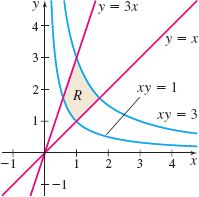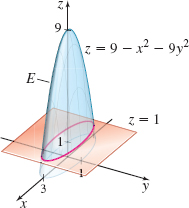14.9 Assess Your Understanding
967
Concepts and Vocabulary
Question
For a change of variables from \(x\) and \(y\) to \(u\) and \(v\) given by \(x=g_{1}(u,v)\) and \(y=g_{2}(u,v),\) the Jacobian is the determinant _____.
Question
True or False When introducing a Jacobian into an integral because of a change of variables, the absolute value of the Jacobian is used.
Skill Building
In Problems 3–10, find the Jacobian \(\dfrac{\partial (x,y)}{\partial (u,v)}\) for each change of variables from \((x,y)\) to \(( u,v).\)
Question
\(x=u+v,\quad y=u-v\)
Question
\(x=u+5,\quad y=v-7\)
Question
\(x=4u-v,\quad y=3u+\dfrac{1}{2}v\)
Question
\(x=u^{2}-v^{2},\quad y=u^{2}+v^{2}\)
Question
\(x=\dfrac{u}{v},\quad y=u+v\)
Question
\(x=e^{u}\cos v,\quad y=e^{u}\sin v\)
Question
\(x=ve^{u},\quad y=ue^{-v}\)
Question
\(x=u\cos v,\quad y=v\sin u\)
In Problems 11–16, find the Jacobian \(\dfrac{\partial (x,y,z)}{ \partial (u,v,w)}\) for each change of variables from \((x,y,z) \) to \((u,v, w).\)
Question
\(x=u+v+w,\quad y=u+v-w,\quad z=u-v-w\)
Question
\(x=2u+v+w,\quad y=u+v-w,\quad z=u-v\)
Question
\(x=u+v,\quad y=v-w,\quad z=u-w\)
Question
\(x=u+v+w,\quad y=u+v,\quad z=w\)
Question
\(x=u,\quad y=v^{2},\quad z=w^{3}\)
Question
\(x=3 ( u+v) ,\quad y=u-w,\quad z=u^{2}-w^{2}\)
Question
Area Find the area of the region \(R\) enclosed by \(y=4\sqrt{1- \dfrac{x^{2}}{9}}\) and \(y=0,\) using the change of variables \(u=\dfrac{x}{3}\) and \(v=\dfrac{y}{2}.\)
Question
Area Find the area of the region \(R\) enclosed by \(xy=1,\) \(xy=3,\) \(y=x,\) and \(y=3x\) using the change of variables \(u=x\) and \(v=xy.\) See the figure.

In Problems 19–22:
- Graph the region \(R\) in the \(xy\)-plane.
- Graph the region \(R^{\#}\) in the \(uv\)-plane.
- Find the Jacobian \(\dfrac{\partial (x,y) }{\partial (u,v) }\).
- Change the variables and find the integral.
Question
\(\iint\limits_{\kern-3ptR}x\,{\it dA}\), where \(R\) is the region enclosed by \(2x-y=0\), \(2x-y=4\), \(x+y=0\), and \(x+y=3\). Use the change of variables \(u=2x-y\) and \(v=x+y\).
Question
\(\iint\limits_{\kern-3ptR}(x^{2}+y^{2})\,{\it dA}\), where \(R\) is the region enclosed by \(2x-y=1\), \(2x-y=3\), \(x+y=1\), and \(x+y=2\). Use the change of variables \(u=2x-y\) and \(v=x+y.\)
Question
\(\iint\limits_{\kern-3ptR}xy\,{\it dA},\) where \(R\) is the triangular region whose vertices are \((-1,1)\), \((1,1)\), and \((0,0)\). Use the change of variables \(u=x+y\) and \(v=x-y\).
Question
\(\iint\limits_{\kern-3ptR}(x+ y)\) sin\((x-y) {\it dA}\), where \(R\) is the triangular region whose vertices are \((-1,1)\), \((1,1)\), and \((0,0)\); use the change of variables \(u=x+y\) and \(v=x-y\).
In Problems 23–26, find each integral.
Question
\(\iint\limits_{\kern-3ptR}(3x-2y)\,{\it dA}\), where \(R\) is the region enclosed by the ellipse \(9x^{2}+16y^{2}=144.\) Change the variables using \(u=\dfrac{x}{4}\) and \(v=\dfrac{y}{3}.\)
Question
\(\iint\limits_{\kern-3ptR}(x^{2}-y)\), \({\it dA}\), where \(R\) is the region enclosed by the ellipse \(9x^{2}+16y^{2}=144.\) Change the variables using \(u=\dfrac{x}{4}\) and \(v=\dfrac{y}{3}.\)
Question
\(\iiint\limits_{\kern-3ptE}(x+1)\,{\it dV}\), where \(E\) is the solid enclosed by the ellipsoid \(\dfrac{x^{2}}{4}+\dfrac{y^{2}}{4}+ \dfrac{z^{2}}{9}=1.\) Change the variables using \(u=\dfrac{x}{2}\), \(v=\dfrac{y }{2}\), and \(w=\dfrac{z}{3}.\)
Question
\(\iiint\limits_{\kern-3ptE}(x+2y)\,{\it dV}\), where \(E\) is the region enclosed by the ellipse \(\dfrac{x^{2}}{9}+\dfrac{y^{2}}{4}+z^{2}=1.\) Change the variables using \(u= \dfrac{x}{3}\), \(v=\dfrac{y}{2},\) and \(w=z\).
Applications and Extensions
In Problems 27–30, for each integral:
- Graph the region \(R.\)
- Choose a change of variables from \((x,y) \) to \((u,v).\) Graph the new region in the \(uv\)-plane.
- Write each integral using the new variables.
- Find each integral.
Question
\(\iint\limits_{\kern-3ptR}x^{2}y\,{\it dA}\), where \(R\) is the region enclosed by the lines \(2x-3y=0\), \(2x-3y=1\), \(x+2y=0\), and \(x+2y=3\)
Question
\(\iint\limits_{\kern-3ptR}x\,{\it dA}\), where \(R\) is the region enclosed by the ellipse \(\dfrac{x^{2}}{9}+\dfrac{y^{2}}{16}=1\)
Question
\(\iint\limits_{\kern-3ptR}x\cos (xy) \,{\it dA}\), where \(R\) is the region enclosed by \(xy=1\), \(xy=3\), \(x=1\), and \(x=3\)
Question
\(\iint\limits_{\kern-3ptR}ye^{xy}\,{\it dA}\), where \(R\) is the region enclosed by \(xy=1\), \(xy=3\), \(x=1\), and \(x=3\)
Question
Area Use a change of variables to find the area of the region \(R \) enclosed by the lines \(y=3x,\) \(y-3x=2,\) \(2y+x=0\), and \(y=-\dfrac{1}{2} x+5\).
968
Question
Area Use a change of variables to find the area of the region \(R \) enclosed by the lines \(x+y=1\), \(x+y=-3,\) \(y=2x\), and \(y=2x+4\).
Question
Volume Use a change of variables to find the volume \(V\) of the solid \(E\) enclosed by the planes \(x+2y=0,\) \(x+2y=3,\) \(y-z=0,\) \(y-z=2\), \(z=0,\) and \(z=6.\)
Question
Volume Use a change of variables to find the volume \(V\) of the solid \(E\) enclosed by the planes \(x-y=0,\) \(x-y=3,\) \(z-2x=0,\) \(z-2x=4\), \(z=1,\) and \(z=5.\)
Question
Volume Find the volume of the solid \(E\) enclosed by the paraboloid \(z=9-\) \(x^{2}-9y^{2}\) and the plane \(z=1,\) given the change of variables \(x=3u\cos v,\) \(y=u\sin v,\) and \(z=w\). See the figure.

Question
Volume Find the volume of the solid \(E\) enclosed by the ellipsoid \(\dfrac{x^{2}}{4}+\dfrac{y^{2}}{9}+z^{2}=1\) above the \(xy\)-plane, given the change of variables \(u=\dfrac{x}{2}\), \(v=\dfrac{y}{3},\) and \(w=z.\)
Question
Show that in changing from rectangular coordinates \((x, y, z)\) to spherical coordinates \((\rho, \theta, \phi)\), the triple integral of \(f\) over \(E\) becomes \begin{eqnarray*} &&\iiint\limits_{\kern-18ptE}f(x, y, z)\,{\it dV}\\[4pt] &&\quad=\iiint\limits_{\kern-18ptE^{\#}}f(\rho \sin \phi \cos \theta , \rho \sin \phi \sin \theta , \rho \cos \phi )\rho ^{2}\sin \phi \,d\rho \,d\theta \,d\phi \end{eqnarray*}
Challenge Problems
Question
A region \(R\) is enclosed by the graphs of \(xy=2,\) \(xy=5,\) \(y= \sqrt{x},\) and \(y=3\sqrt{x}\).
- Graph the region \(R.\)
- Use a change of variables that transforms \(R\) into a rectangular region \(R^{\#}.\)
- Find the area of \(R.\)
